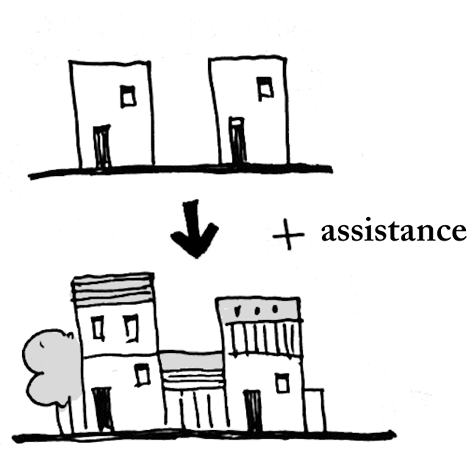…In Slum Upgrade and other forms of Urban Regeneration, it is often necessary as well as beneficial to harness the capacity of people to build for themselves.

__Problem-statement: Often residents of informal settlements do not have the capability to build all at once, or with the services of builders or contractors. Nor do they have the capability to buy existing homes.__
Discussion: The simplest way to handle this challenge is a practice that goes on around the world every day: people build for themselves. There are many advantages to this practice. People know best what their own needs are, and know when they are able to devote the time and expense to construction. They also tend to produce more unique and creative results.
Of course, there are drawbacks too. One of the most important is simply that individual residents may not have the skill to produce a good quality building that is attractive, functional, or perhaps even safe. They may run afoul of many regulations designed to protect the life and safety of residents and visitors, as well as the interests of neighbors and the public in a supportive contribution to the public realm.

Self-build homes, businesses and public realm in Rose Town, Jamaica. Photos by Steve Mouzon.
Yet there are many examples of self-build structures that are very beautiful and successful. What is needed is guidance, in the form of design resources, assistance, instruction, training and the like. This can be provided at the local level by those who today may be trying to stop self-build schemes: building inspectors, plans examiners, and other building authorities.
__Therefore: Provide resources for people to self-build their own homes and other buildings incrementally, as they are able to afford the construction and have the time.__

Provide for the skills needed in the Neighborhood Planning Center, including pattern language resources and Entitlement Streamlining…
notes
¹ A further discussion of this topic is in Bredenoord, J., & van Lindert, P. (2010). Pro-poor housing policies: Rethinking the potential of assisted self-help housing. Habitat International, 34(3), 278-287.
See more Informal Growth Patterns